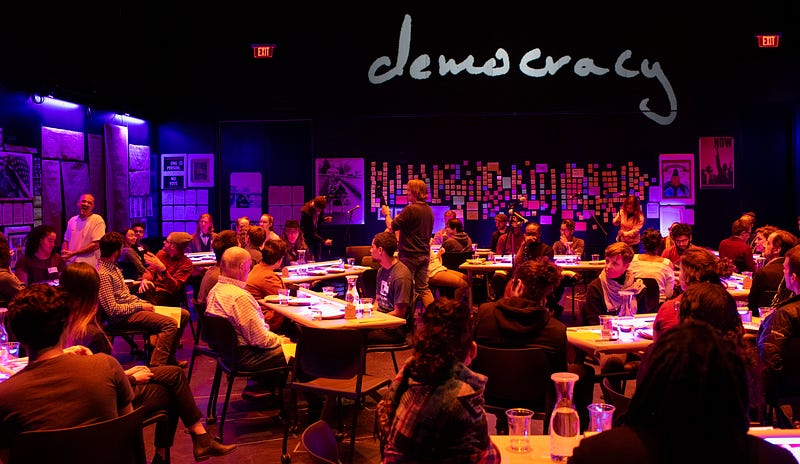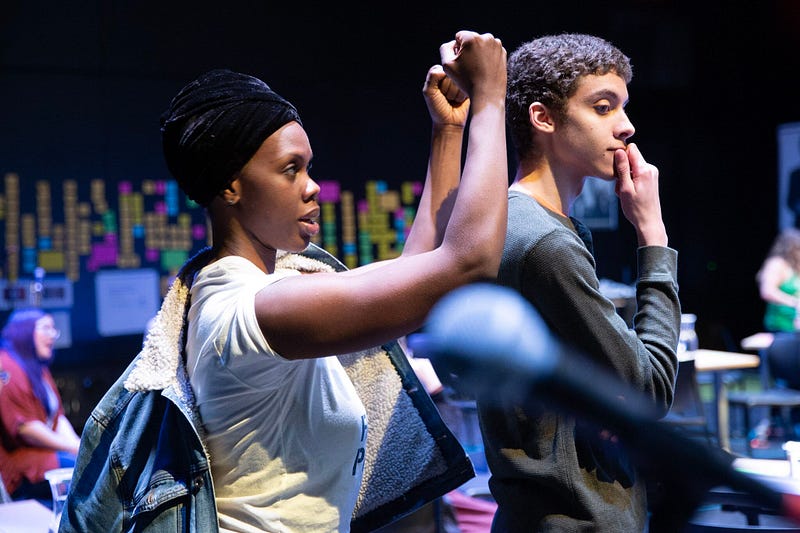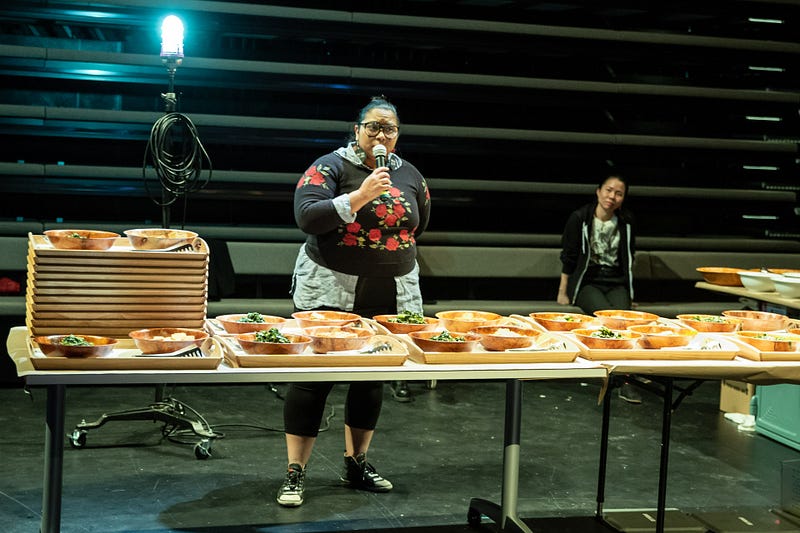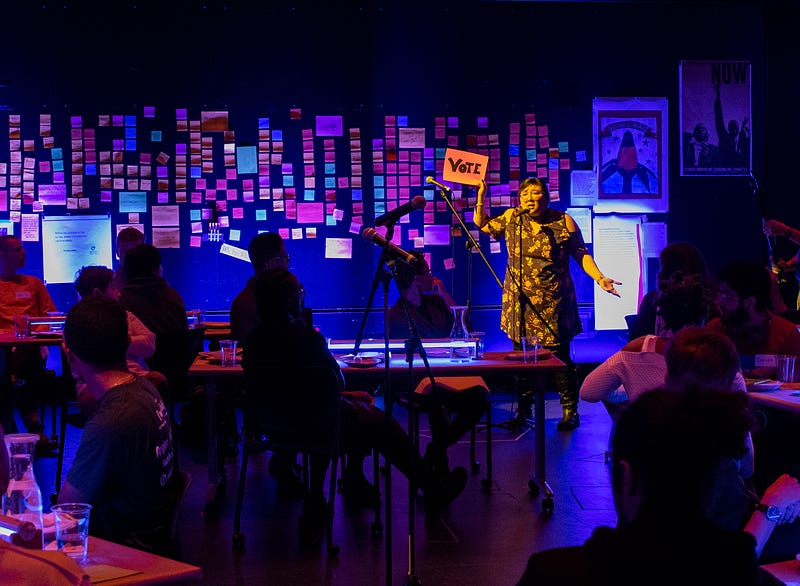
We, The People
Casting the Vote Serves Up Traditional American Food and Raises Hard Questions About Participation in Democracy
 An evening
of theater, song, discussion, and a meal — dedicated to the proposition that “We, the People” indeed
includes all of us.
An evening
of theater, song, discussion, and a meal — dedicated to the proposition that “We, the People” indeed
includes all of us.As part of our series for the Collective Wisdom field study, we commissioned this original piece on the co-creative process behind Casting the Vote.
It began when I, a veteran journalist, realized I had been duped by the Russian Intelligence Agency.
In the fall of 2017, I read an article in The Guardian by my Columbia University colleague Jonathan Albright about fake Facebook accounts that had been set up to manipulate public opinion in the lead up to the 2016 election. Albright is a scholar at the Tow Center for Digital Journalism at Columbia Journalism School, where I have been a professor for 20 years. As I examined the data he’d collected on Tableau, one of the account names struck me — Blacktivist.
I’d been following Blacktivist the previous year. Its posts were of the “feel-good” variety, things of cultural interest to African-Americans: elementary school kids reciting heroes of black history; or an actor describing the problem of colorism and casting in Hollywood. I had noticed the anti-Hillary political turn the account took in the lead up to the election, and stopped reposting. Still, if I — a veteran journalist—could be fooled by a fake account, how many others were? And how could we, as a people, begin a conversation about how to counter that effect?
One of my mentors, the filmmaker Henry Hampton (Eyes on the Prize) used to say that the story of African-Americans in the United States was the story of a people advancing the democratic project, and their lived experience was a litmus test for whether that democracy would survive. In the 2016 Prsidential election, nearly two million black voters abstained — the first real decline in black voter turnout in nearly twenty years. Their absence was particularly marked in the key states of Wisconsin, Pennsylvania, Ohio, Florida, and North Carolina. The lackluster Democratic candidate was certainly part of the problem, but as I dug deeper, I realized that changes in the Voting Rights Act also played a role. In Shelby v. Holder, a Supreme Court case decided in 2013, justices had voted 5–4 to gut a key provision in the Voting Rights Act. Changes in voter registration and polling procedures had followed swiftly, especially in states with Republican state legislatures. In Wisconsin, for example, Republicans managed to retained control of the state house despite receiving losing the popular vote. I had spent much of the fall, after the 2018 election, studying how social media manipulation impacted both the 2016 and 2018 vote.
But how do you make an audience care about the mechanisms of democracy, and more fundamentally, how it was being systematically undermined? Was there a way to make the facts and reams of data “performative” in a way that engaged audiences?
 Director
Charlotte Brathwaite and cast member Robert Thorpe
Director
Charlotte Brathwaite and cast member Robert ThorpeThis question led me to seek collaboration with Charlotte Brathwaite, a director with a reputation for collapsing the walls between disciplines in her site specific works, and to apply for a grant from the Brown Institute for Innovation in Media. MIT’s Open Doc Lab emboldened me to push the boundaries between journalism and theater. If virtual reality creates empathy, could the real reality of theater induce greater engagement?
I shared the bulk of my research with Charlotte’s long-time collaborators, writer Janani Balasubramanian and dramaturg Sunder Ganglani. Janani “re-mixed” my research into a script that highlighted the history and the struggles of voting rights in the United States. The script appeared heavy on the history when I read it; but when I heard it performed, I realized how the tradition of voter suppression, going back to the beginning of gerrymandering in Massachusetts in 1813, was very much alive. When I recounted this history at one of the rehearsals, I found myself cast as a performer in the preamble to the work itself! While I’m accustomed to playing a certain role in the documentary essays I do, performing live was — well, different. Any reporter wants to sit behind their work, not center themselves in it. However, since the cast worked as an ensemble, my role as instigator and investigator seemed apt.
The script itself worked like a fugue, individual actors taking tangential narrative leaps that then became part of the chorus.We put out a call for auditions at the beginning of the semester, and soon had a troupe of nine actors.
At one of the first rehearsals, our small cast for “Casting the Vote,” as we called it, sat on the floor in a rehearsal hall at MIT’s Theater Arts department. None of us knew each other, and Brathwaite had come up with a plan to break the ice. “We’re going to perform the Constitution,” she announced.
At first, we read the words like primary school children. It took a while to infuse the words “We the people” with real meaning; and even longer to absorb the nineteenth century English encrusted around the first, 13th, 14th, and 15th amendments, which the late Supreme Court Justice Thurgood Marshall once said gave real meaning to the document. (The 13th outlawed involuntary servitude, except for prisoners; the 14th established equal rights under law; the 15th established that the right to vote could not be denied.) We read them over and over, echoing some phrases, questioning others, asserting the irony, laughing at the tortuous grammar (one sentence in the 14th amendment has 16 commas!) and the majesty of the document. Charlotte made us read and re-read, until we finally put the paper down and our voices gave meaning to the words.
Performing the Constitution: 13th Amendment Early rehearsal for "Casting the Vote"vimeo.com
I shared my research on social media manipulation with the actors. As a group, we studied the heroes and heroines of the Voting Rights struggles in the 1960s. We imagined and discussed those struggles and victories, and their personal cost. In my research, I had found archival film from The Streets of Greenwood, a 1964 documentary by Jack Willis. It portrayed the antagonism facing voting rights advocates in Mississippi. My longtime editor, Robert Salsbury, did a mash-up of that film with a second archival documentary we found at Mississippi State University, combined it with footage from ProPublica’s Electionland project, and my own footage from Wisconsin (funded separately through a research grant from the Ford Foundation) in the lead up to the 2018 election. It screened on the walls and projected on the tables during the opening of the evening.
Casting the Vote workshopped at the MIT Theater Arts Department April 10–13, 2019. The audience and the actors co-created the performance each night, listening to and singing music designed to reinforce the idea that democracy is a process that unfolds person-to-person, moment-to-moment, all while enjoying a free meal of cornbread, corn, greens, and chili. Chef Mea Johnson from the Olio Culinary Collective, a Native American from the Wampanoag nation, designed the meal to honor Native American and African-American traditions. At dress rehearsal, she pointed out that the film we’d edited omitted mention of how Native Peoples in North Dakota had been prevented from voting because they have post office boxes instead of street addresses. We asked her to add those comments as she explained the meal.
 Mea Johnson
of the Olio Collective explains how stringent voter registration laws inhibit Native American
voters.
Mea Johnson
of the Olio Collective explains how stringent voter registration laws inhibit Native American
voters.After a dessert of sweet potato pie, diners examined the “set” — a mash-up of my journalistic research, historical artifacts from those who fought to get the 1964 Voting Rights Act passed, and photographs of martyrs to that cause. Every word in the script represented the history or the lived experience of those who fought for the right to vote. The performers alternated as narrators and characters. One hearing-impaired cast member recited the preamble in American Sign Language — the emotional climax of the evening.
As journalism, the performance engaged participants in the deepest themes of the work: their relationship to democracy, and the necessity for their participation in keeping it vibrant, especially outside the voting booth. Many came to a new understanding of themselves as active players in this ongoing story of struggle for equality, justice, and transparency. The freshest moments were unscripted: strangers from countries as disparate as Bulgaria, Israel, and China passed the cornbread as they shared stories of voter suppression in their own countries and communities of origin; local organizers explained their work to university students, and offered pathways for building stronger town-gown relationships. Afterwards, the performers said they felt inspired to explore volunteering and organizing as ways of engaging in democracy, which, after all, comes from the Greek “dēmos” (the people) and “kratie” (to rule).
We are hoping that Casting the Vote develops a long shelf life, particularly as we head into the 2020 election season. We are particularly eager to translate the datasets surrounding the stories of voter manipulation on Facebook, Twitter, Youtube, and Instagram — using actors to represent those fake accounts. While social media manipulation has been studied in the academy and within the U.S. Congress, the realities have yet to become part of the public discourse. We hope to change that by creating moments of audience interactivity, using actors to represent both the manipulative personas who have been so central to disrupting civil discourse, and those who have been key to advancing democracy.
 Erica Chan
tells the story of Alabama coal miner Leon Alexander, who tried in vain to register to vote.
Erica Chan
tells the story of Alabama coal miner Leon Alexander, who tried in vain to register to vote.
While it is challenging co-creating the work every night, it’s also exciting to engage with audience members in the moment. We will have to figure out how to scale the work for broader distribution, and how to react to evolving news. We want to keep these “performance meals” free; we need to involve people of disparate political views. All this requires more resources; still, we hope to develop Casting the Vote into an evening of theater that asks its audiences to work together with its performers to enhance civil discourse; in many ways, prototyping the very ambitious democratic processes we lift up in the content.
This article is part of Collective Wisdom, an Immerse series created in collaboration with Co-Creation Studio at MIT Open Documentary Lab. Immerse’s series features excerpts from MIT Open Documentary Lab’s larger field study — Collective Wisdom: Co-Creating Media within Communities, across Disciplines and with Algorithms — as well as bonus interviews and exclusive content.
Immerse is an initiative of the MIT Open DocLab and The Fledgling Fund, and it receives funding from Just Films | Ford Foundation and the MacArthur Foundation. IFP is our fiscal sponsor. Learn more here. We are committed to exploring and showcasing media projects that push the boundaries of media and tackle issues of social justice — and rely on friends like you to sustain ourselves and grow. Join us by making a gift today.